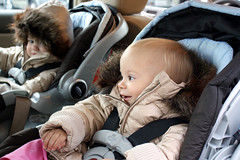Disclosure: This post may contain affiliate links, meaning we get a commission if you decide to make a purchase through our links, at no cost to you. Please read our disclosure for more info.

Choosing a car for the family is a big decision. Finding a car that is affordable to purchase, insure, and maintain are important factors to consider. Finding one that fits the entire family without being too large is equally important. For families with multiples, this can be an even greater task, especially when your kids need car seats.
Small Cars
Smaller vehicles are more economical than larger vehicles. Therefore, finding the smallest car possible to comfortably handle all members of the family is the best choice. For families with twins, small cars are a viable option. With this choice, trunk space is important. Whether using a double stroller or two umbrella strollers, the trunk needs to be large enough to carry the necessary equipment when going on outings with twins. Smaller cars can easily handle two car seats with plenty of room for the little passengers.
Smaller cars may be cheaper to purchase, depending on the make and model. This helps to lower car payments, or you can eliminate them by paying with cash. Insuring smaller vehicles designed for families may also be more affordable. For a large family, lowering or reducing any bill is an advantage that can’t be passed up.
Older Vehicles
Families with triplets or quadruplets may be comfortable in older vehicles that have three seats in the front and back seats. These vehicles are less expensive than newer models and are typically cheaper to repair. For the mechanic in the family, older vehicles are actually easier to repair than newer models. Older cars have a tendency to be more reliable than newer vehicles due to better manufacturing.
There is usually plenty of trunk space for strollers and other equipment necessary for family outings., but every vehicle is different so it’s always important to check before purchasing. Depending on the year of the vehicle, you can purchase it outright for just a few thousand dollars, allowing you to avoid car payments, and insurance is much lower than for newer ones, making the daily cost of an older vehicle more cost effective than one that’s right off the lot.
Sports Utility Vehicles
If older vehicles aren’t an option, another choice for families with multiples is an SUV. The smaller versions are fairly economical while still providing the room necessary to transport larger families. These vehicles can be expensive to purchase when buying new, making used vehicles a better choice. When chosen carefully, it’s still possible to have an SUV without buying more car than is necessary.
However, insurance rates for an SUV can be high. They were designed for off-road driving and insurance companies charge accordingly. They are not as safe as cars because they have a higher center of gravity, and they also cause more damage to other vehicles and passengers when involved in an accident. Therefore, an SUV should be a last choice when possible.
Minivans
These vehicles are not the most fuel efficient, although they do rate higher than most sports utility vehicles. Pricing is lower than that of an SUV and there’s plenty of room for twins, triplets or larger families. Minivans are much safer than larger vehicles because they have a lower center of gravity. This causes less damage to other vehicles when involved in a collision. These factors, along with the knowledge that those wanting a family vehicle will be less likely to drive recklessly, makes minivans one of the least expensive vehicles to insure.
Researching a vehicle before purchasing one is important to determine the appropriate size for the family. One that is as small as possible while providing comfort and room to haul equipment such as strollers is the best choice. Whether your family includes twins, triplets or more, it is possible to find a vehicle that fits while keeping the costs down.
[phpbay]carseat, 2[/phpbay]
